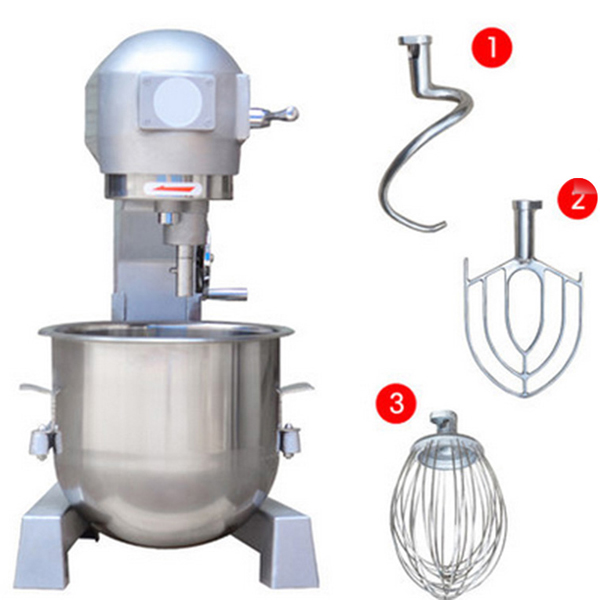Position: Home » Product Wiki » Kitchen Dough Mixer: Definition, Types And Maintenance
Kitchen Dough Mixer: Definition, Types And Maintenance
Kitchen dough mixers rely primarily on their internal mixing system. When the raw materials such as flour and water are added to the mixing bucket of the mixer, the machine is started and the mixer starts to rotate at high speed. During the mixing process, the blades or paddles of the mixer constantly break and mix the ingredients until a uniform, soft dough is formed.
Structure and composition
Body: As the support and fixed part of the mixer, it is usually made of a strong metal material to ensure the stability and durability of the equipment.
Mixing tank: A container for holding and mixing raw materials, usually made of a corrosion-resistant material such as stainless steel, and designed with a removable lid for easy feeding and cleaning.
Mixing system: including stirrer, motor and transmission and other components. Agitator is the core component, its shape and material directly affect the mixing effect; Motor provides power; The transmission device transfers the power of the motor to the agitator.
Control system: used to control the mixer start, stop, speed regulation and other functions. Modern dough mixers are usually equipped with advanced control equipment such as electronic control panel or touch screen, which is easy to operate and powerful.
Type and classification
According to the mixing method, it can be divided into self-falling mixer and forced mixer. Self-falling mixer relies on gravity to mix raw materials; The forced mixer mixes the raw materials through the forced stirring action of the mixer.
According to the structure, it can be divided into vertical mixer and horizontal mixer. Vertical mixer covers a small area, suitable for small-scale production; Horizontal mixers have large capacity and are suitable for mass production.
By function: can be divided into single function mixer and multi-function mixer. In addition to the mixing function, the multi-functional mixer may also have a variety of functions such as blending, fermentation, and waking up.
Use and maintenance
Feeding order: Raw materials should be added in the correct order, usually adding water or liquid raw materials first, and then adding solid raw materials such as flour.
Mixing time: Set the appropriate mixing time according to the requirements of the dough and the performance of the mixer to avoid over-mixing or under-mixing.
Cleaning and maintenance: After use, the mixing drum and stirrer should be cleaned in time to prevent the residue from causing corrosion to the equipment or affecting the effect of next use. At the same time, regular maintenance and maintenance of the equipment to extend its service life.
Structure and composition
Body: As the support and fixed part of the mixer, it is usually made of a strong metal material to ensure the stability and durability of the equipment.
Mixing tank: A container for holding and mixing raw materials, usually made of a corrosion-resistant material such as stainless steel, and designed with a removable lid for easy feeding and cleaning.
Mixing system: including stirrer, motor and transmission and other components. Agitator is the core component, its shape and material directly affect the mixing effect; Motor provides power; The transmission device transfers the power of the motor to the agitator.
Control system: used to control the mixer start, stop, speed regulation and other functions. Modern dough mixers are usually equipped with advanced control equipment such as electronic control panel or touch screen, which is easy to operate and powerful.
Type and classification
According to the mixing method, it can be divided into self-falling mixer and forced mixer. Self-falling mixer relies on gravity to mix raw materials; The forced mixer mixes the raw materials through the forced stirring action of the mixer.
According to the structure, it can be divided into vertical mixer and horizontal mixer. Vertical mixer covers a small area, suitable for small-scale production; Horizontal mixers have large capacity and are suitable for mass production.
By function: can be divided into single function mixer and multi-function mixer. In addition to the mixing function, the multi-functional mixer may also have a variety of functions such as blending, fermentation, and waking up.
Use and maintenance
Feeding order: Raw materials should be added in the correct order, usually adding water or liquid raw materials first, and then adding solid raw materials such as flour.
Mixing time: Set the appropriate mixing time according to the requirements of the dough and the performance of the mixer to avoid over-mixing or under-mixing.
Cleaning and maintenance: After use, the mixing drum and stirrer should be cleaned in time to prevent the residue from causing corrosion to the equipment or affecting the effect of next use. At the same time, regular maintenance and maintenance of the equipment to extend its service life.
